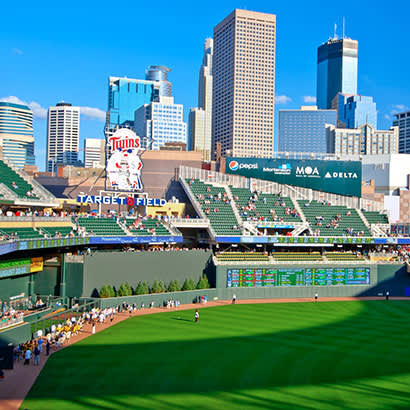
For an enhanced digital experience, read this story in the ezine.
There are several challenges that sports field managers may face while maintaining safe and enjoyable playing surfaces. Depending on the geographic location of the field, the climate could be one of the key challenges. For example, Target Field, home of MLB’s Minnesota Twins, contends with the challenges of summer heat and winter cold. In addition, the field is also known for its environmentally responsible practices.
Head groundskeeper Larry DiVito sheds some light on how climate impacts Target Field.
“Green” Year-Round
Target Field is the first sports franchise in the world to earn the U.S. Green Building Council’s Leadership in Energy and Environmental Design (LEED) Gold Certification for operations and maintenance. It’s also designated as a Sports Turf Managers Association (STMA) Certified Facility for Environmentally Responsible Management.
As part of these efforts, the facility has a system that collects and recycles rainwater and irrigation water, so it can be used to wash down the lower deck of the stadium. According to DiVito, this system saves about 15,000 gallons of water per night.
What Happens in the Offseason Makes a Difference
“From May 1 to Labor Day, my job’s not that different from other northern Major League [Baseball] cities like Chicago, Cleveland, Detroit or Boston,” DiVito says. “It’s more on the front and backend — how you get the field ready for opening day and how you prepare it for winter, so it comes out in good condition.”
For DiVito, that starts with planning. From late September to early November, he has a program to lightly feed the grass and apply fungicides to anticipate snow mold pressure leading into winter. Then, his crew applies double topdressing to help insulate the plants and puts lightweight, breathable agricultural blankets on the field as a buffer in the absence of snow cover.
In the spring, their first move is to clear snow. Depending on how deep it is, they may use a field heating system to gradually melt it or clear it with their rotary mower, which is configured as a snow-only unit. They also can attach a plow to one of their infield groomers. Both machines have a relatively lightweight footprint, which is important on a sand-based natural grass field.
Relying on a Diverse Fleet
In addition to rotary mowers and infield groomers, Target Field’s fleet includes reel mowers, several walk-behind greens mowers, turf sprayers and a greens roller. The grounds team also has a turf aerator, a debris sweeper attachment and a topdresser, as well as diesel, gas and electric utility vehicles and a debris blower (which crew members connect to pipes under the field so they can blow air into the tarps to shed water after a light rain).
Still Busy, But It’s a Bit Different
The Target Field grounds crew includes four year-round positions. Four additional employees join the crew from March through early November.
Although the field’s maintenance requirements haven’t changed during the coronavirus (COVID-19) crisis, the crew has had to make a few adjustments. Physical distancing isn’t difficult with much of the outdoor work, but the crew has been divided into groups with separate locker, meal and office areas to maintain a backup if an employee must quarantine.
In a typical year, the crew would have to schedule a number of special events and concerts, but those were suspended in 2020 because of the pandemic. Still, the shortened Major League Baseball season kept DiVito and his crew busy. “Other than April and May, it was a fairly normal year, baseball-wise,” he says. He anticipates the coming season to look a bit different with the possible return of fans to the stadium this spring.
MLB is a registered trademark of Major League Baseball. Team names are registered trademarks of the teams indicated.
Paula Sliefert is Senior Marketing Manager, Sports Fields and Grounds at Toro.

